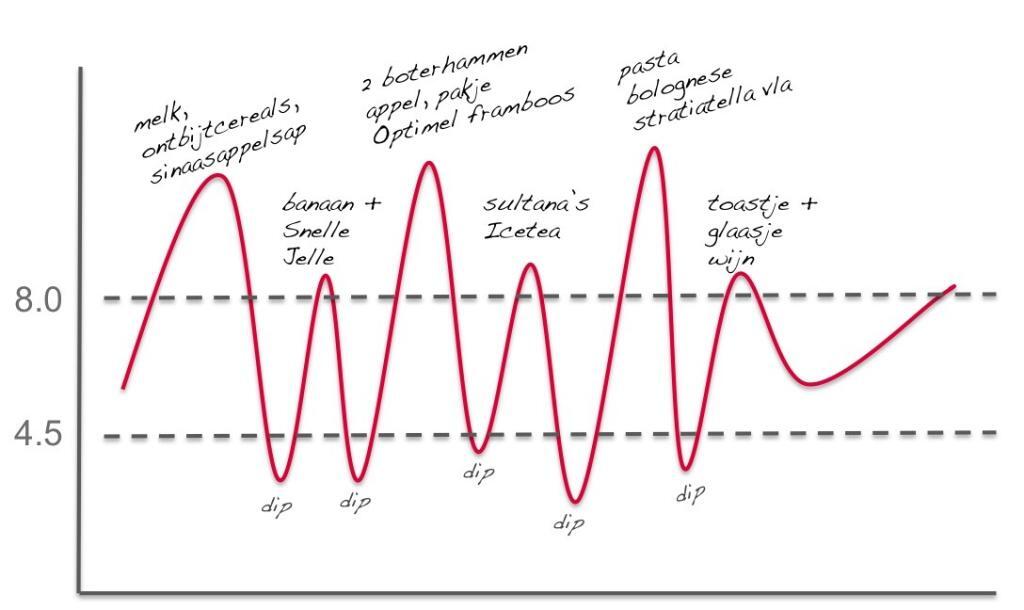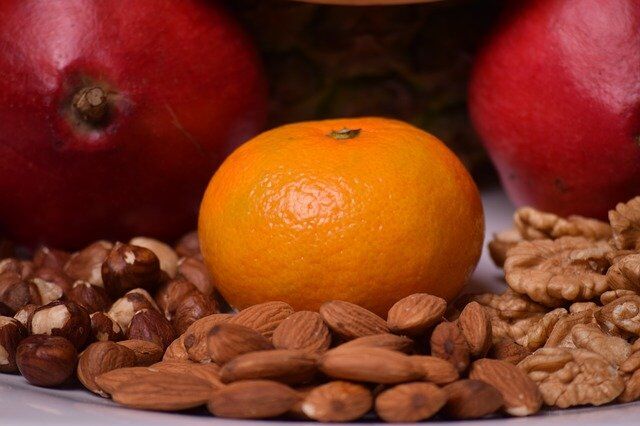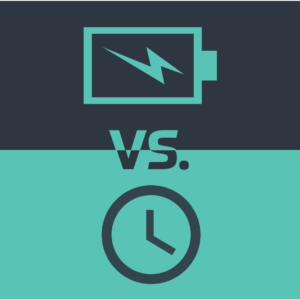Why Everyone Should Know This!
Losing weight and eating less are two things that are often mentioned in the same sentence. If you follow personal training at Sterker dan ooit, we also address persistent eating patterns and provide you with targeted nutritional advice. The first step in losing weight is to ensure a stable blood sugar level. Because only then can your body effectively start burning fat. The result is a healthier weight, a smaller chance of age-related diseases, and more energy. Win, win, win!
What does your blood sugar level do?
The blood sugar level is a measure of the amount of glucose present in the blood. Glucose is used in our body cells as energy. Glucose is found in sugar, but also in all carbohydrates: in fact, long chains of glucose molecules. The blood sugar level is very precisely regulated by our body. The hormone insulin is the key to this: it ensures that our body cells absorb glucose from our diet.
So where is the problem? Unfortunately, the current Western dietary pattern contains so many carbohydrates that it is becoming increasingly difficult for our bodies to keep our blood sugar levels balanced. How is this possible? Our bodies are still tuned to how we have eaten for centuries as hunters/gatherers. Our ancestors ate proportionally more proteins, fats, and significantly fewer carbohydrates. The rise of refined products with fast sugars and a higher frequency of meals per day now leads to severe fluctuations in our blood sugar levels. The pancreas therefore produces insulin non-stop. These large amounts of insulin then cause our cells to become less sensitive to insulin.
When is your blood sugar level out of balance?
Ideally, the blood sugar level is between 4 and 6.5 mmol/liter. When the blood sugar level is above the target values, hyperglycemia occurs. When the blood sugar level is below the target values, hypoglycemia occurs.
Hyperglycemia occurs when the body is no longer sensitive to insulin, or when the cells in the pancreas produce less insulin. The glucose remains circulating in the blood, resulting in a high blood sugar level. Due to a lack of glucose in the cells (fuel), there is an energy deficit here. This signals the liver to retrieve glucose from the reserves and send it back into the blood. This way, the glucose level rises even more. At this stage, where the body no longer responds to insulin, insulin resistance occurs. More and more insulin must be produced to still be able to bring the glucose into the cells. If this happens too often and for a long time, it can ultimately lead to type 2 diabetes.
"At the moment, more than 1 million Dutch people suffer from type 2 diabetes. 1000 new cases are added per week! These are shocking figures."
Hypoglycemia is the result of too much insulin in the blood, which is no longer in proportion to the amount of glucose present. The blood sugar level then drops too much. In this case, there is an incredible ravenous hunger, and you feel like you MUST eat because otherwise, you can’t do anything anymore. Diabetics suffer from this when too much insulin has been injected. But it also occurs when your body is still somewhat sensitive to insulin and you eat a lot of fast carbohydrates from sugars and refined products. Think of cookies, white flour products, and muesli. As a result, the blood sugar level rises faster than our body can handle. The pancreas responds to this delayed, in combination with an overreaction of insulin production to quickly lower the sugar level. Because too much insulin is produced, the blood sugar level drops below the target value.

How to Recognize Hypoglycemia?
Common symptoms of hypoglycemia include:
- Feeling very hungry between meals or at night
- Inability to skip a meal
- Shaking, light-headedness, and irritability when a meal is delayed.
High peaks in your blood sugar are caused by eating foods with a high glycemic index and glycemic load (see figure), but also by eating too frequently. The glycemic index is a measure of how quickly the sugars from a food are absorbed into the blood. Foods with a high glycemic index cause the blood sugar to rise much faster than foods with a low glycemic index. Note: Not only the glycemic index, but also the glycemic load is important when assessing foods. The glycemic load also takes into account the amount of sugars per serving. A certain product may have a high glycemic index, but if you eat little of it, the effect on your blood sugar level is moderate.
A disturbed blood sugar level: The Effect on Weight Loss
Losing weight is difficult if your blood sugar level is not balanced. Why? It depends on whether you are a sugar burner or a fat burner.
When there is a lot of sugar in your blood, your body does not need to burn fat for extra energy. Glucose is a “cheap” fuel; it costs the body little energy to convert it into fuel for the cells. High insulin levels signal to your body that there is a lot of sugar in the blood that needs to be used. Hence, with high insulin levels (which is often the case with insulin resistance), the burning of fat from your fat cells is blocked.
From Glucose to Fat
Insulin not only facilitates the absorption of glucose into regular cells, but it also ensures that excess glucose is taken up into fat cells when the stores in the liver and muscles are full. Once in the fat cells, glucose is converted into fat. This is why eating too much sugar and carbohydrates leads to overweight.

No Satiation Signal
Insulin uses the same enzyme complex (substances that support the hormone to function) as leptin. Leptin is the hormone responsible for the feeling of satiety. When the enzyme complexes are depleted due to excess insulin, there is not enough left for leptin, and no signal can be sent indicating satiety. Therefore, you do not receive a signal that you are full.
A Vicious Eating Cycle
Hypoglycemia causes intense hunger. When you eat something with a high glycemic index, a rapid sugar peak (energy!) is followed by a deep drop below the target value. This leads to a tremendous hunger, which is often satisfied with a quick snack (granola bar, cookies). The quick snack then produces another high peak followed by a drop below the target level. This creates a vicious cycle that makes you feel hungry so often that you easily consume too much energy.
Other Health Problems
Losing weight becomes quite difficult if you have a disturbed blood sugar level because it, in various ways, contributes to retaining fat cells. But in addition to this, fluctuations in blood sugar levels have many other adverse effects on your health. More and more researchers conclude that insulin plays a central role in aging. Prolonged high insulin levels in your blood can lead to, among other things, faster blood clotting, resulting in heart and vascular diseases, plaque formation on the edges of the veins (which can lead to heart attacks), and easier formation of cancers.
Possible consequences of blood sugar levels fluctuating due to an incorrect eating pattern include:
- Heart and vascular diseases
- Chronic fatigue
- Inflammation
- Increased risk of cancer
- Weakened immune system
- Memory loss
- Depression
How to Restore Blood Sugar Balance?
The amount of carbohydrates we can eat varies from person to person. Sometimes people function very well on a lot of carbohydrates. They are often naturally slim. However, for most people, the amount of carbohydrates in the modern menu does not correspond to the amount we burn. In this case, you must earn your carbohydrates through physical activity (sugar burning) and maintaining a healthy blood sugar level and insulin sensitivity. The less sensitive your cells are to insulin, the more you will need to limit the amount of carbohydrates to return to a healthy level.
The simplest rule: Carbohydrates with fiber are good. Carbohydrates without fiber should be avoided as much as possible.
Carbohydrates low in fiber include:
- Processed or refined carbohydrates from beverages
- Fruit juices
- White bread, white pasta, pastries, and similar products
Whole carbohydrates can be found in:
- Vegetables
- Seeds
- Legumes
If your body is already on its way to hyperglycemia and/or insulin resistance, it is advisable to also be cautious with the carbohydrates in fruits, root vegetables, and whole grains. In the previous blog, we emphasized the importance of eating vegetables, and with vegetables, you score well on the glycemic index and glycemic load, with at least two daily portions. This keeps the blood sugar level stable and helps you maintain your weight. If glucose is continuously available, your body “forgets” that it is also capable of burning fat. It becomes increasingly difficult to burn fat, while your fat cells hold onto the energy. This creates a contradictory effect: There is an energy deficit in the cells, while despite having enough energy in the form of fat, you still receive hunger signals.
It is high time, therefore, to become a fat burner again instead of a sugar burner.





